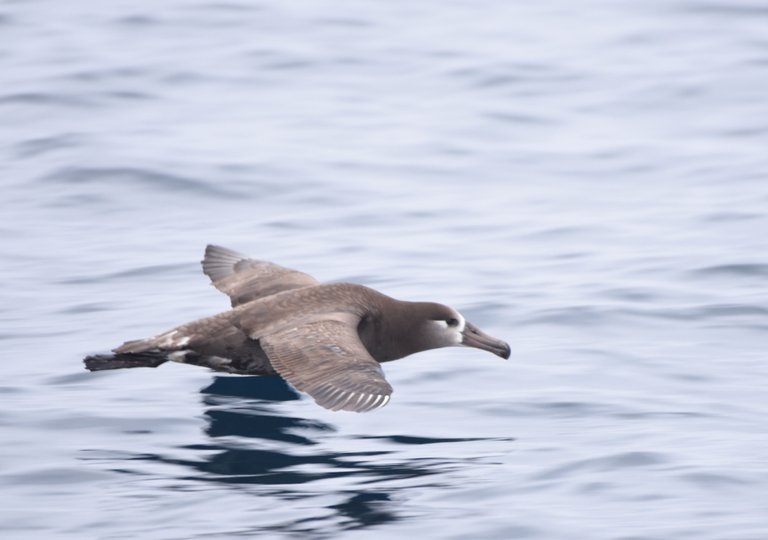
Black-footed Albatross. Probably a breeding age bird with significant white on the belly and underrated.
As promised this is the first post on the common pelagic bird species found off the coast of Washington State in the U.S. My impetus to write these posts is that I’ve agreed to give a presentation to my birding club on these species soon, so it’s getting two uses of the work for me. Hopefully readers will find it interesting and useful.
The first species I’ll tell about is the Black-footed Albatross (Phoebastria nigripes) . We find only two species of albatross with any frequency off the WA coast, the commonly seen Black-footed Albatross, and much less often Laysan’s Albatross. Other species are quite rarely seen.
Although these are huge birds, they are a relatively small albatross, with a wingspan of 193-216 cm (76-85 inches) and a length of 64-74 cm (25-29 inches) and weigh about 2.8 kg. Like other albatrosses they breed on land, and spend the rest of their lives at sea. Nearly their entire breeding population is in the Hawaiian Islands, with maybe 5% in islands off Japan, with reported breeding sites off Baja California and in the Marshall Islands. (source BNA online)
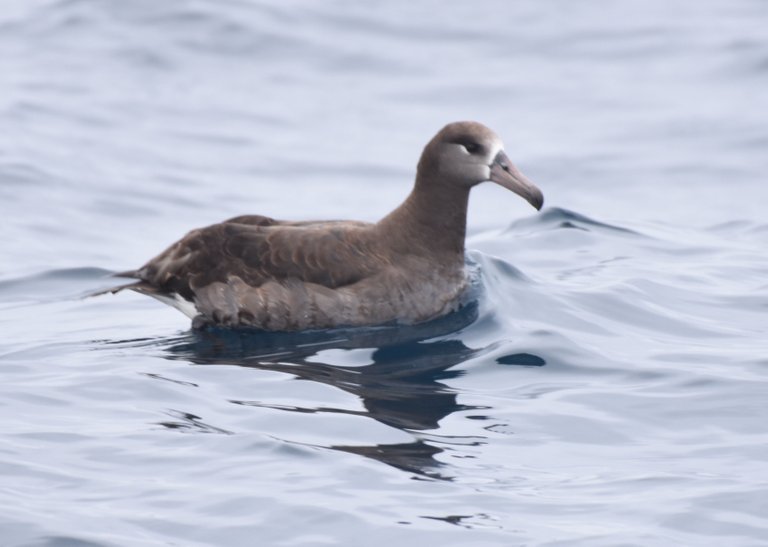
Black-footed Albatross. Note the "tube nose" structure that is used to excrete salt so they can survive drinking sea water and eating a high-salt fish diet.
Identification is pretty straight forward in the Pacific Northwest, as they are the only all-dark albatross in that range. The only somewhat similar species found very rarely in the north Pacific is the juvenile Short-tailed Albatross which has bright pink feet and bill (not dark colored like the Black-footed Albatross).
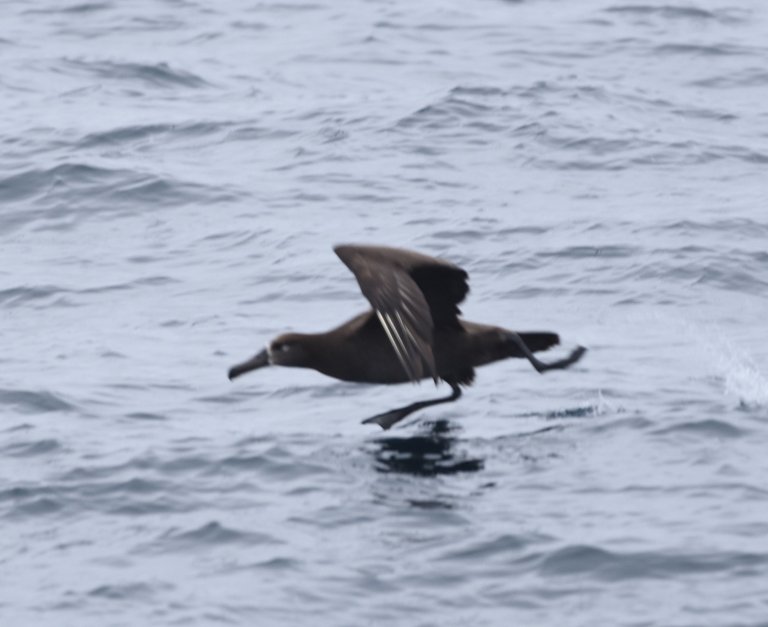
Names for their black feet, visible in this photo.
When not breeding this species moves widely, and even during breeding travel great distances to feed. They breed primarily high on beaches, but also in vegetated areas of remote islands. Their nest is often just a scooped out area of sand, sometimes including a bit of vegetation. They lay just a single egg in a year, and like most albatrosses the incubation period is longer than expected for the egg size, an average of 65-66 days. Both sexes participate in egg incubation, and the egg is continuously incubated. Incredibly the non-incubating individual of the pair is away at sea feeding for up to 18 days, with only 5-8 changes in position. After hatching the chick is confined to the nest (nidicolous), fed by the parent (ptilopaedic) and only partially able to control its temperature (semi-precocial). The eyes are open and it has grayish white-tipped down.
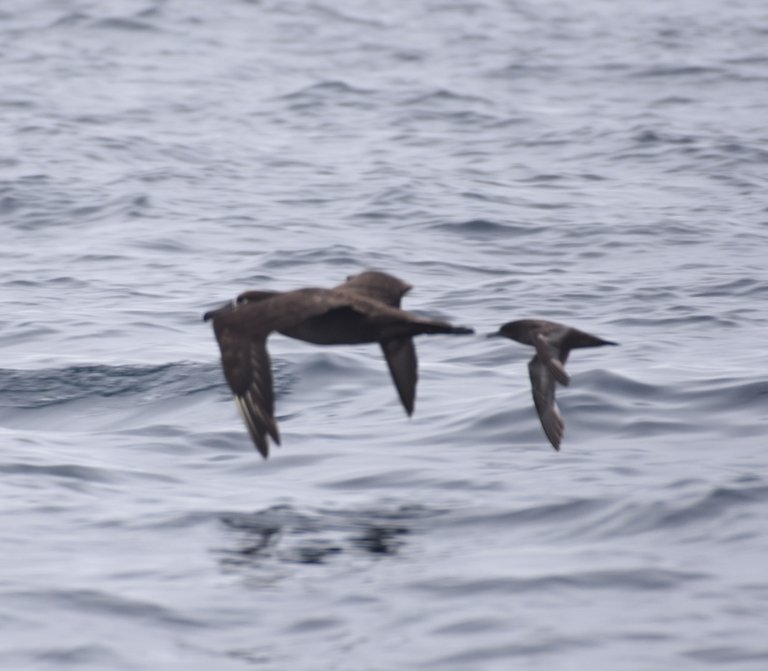
Note the size comparison to the Sooty Shearwater (the smaller bird) which itself is a medium sized shearwater.
Interestingly after hatching the feet, beak and legs grow linearly, and the wings grow exponentially. The parents brood them for help with body temperature until about 20 days of age, after which they are left unattended part of the time for about another 10 days. Nestlings are fed about once a day during the first 2 weeks, then about every 2 days for the next couple or weeks, then about every 3 days. Feeding is by the parent regurgitating into the nestling’s throat.
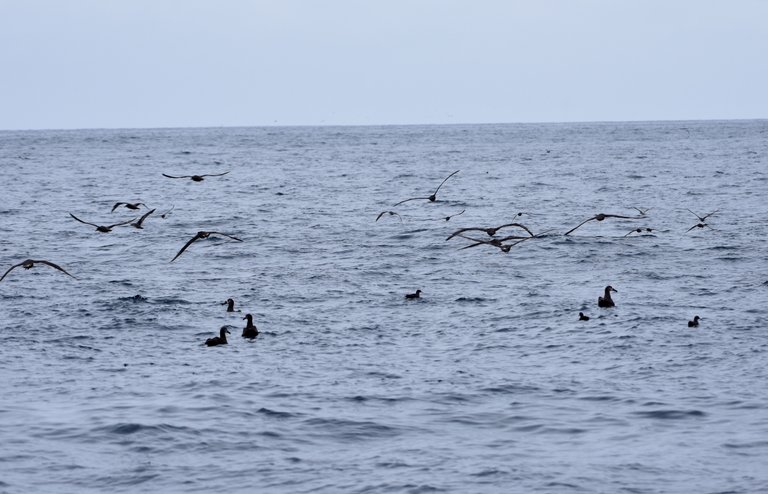
Black-footed Albatross along with other seabirds congregate in large flocks around food sources like the Hake fishing fleet near this flock.
Overall the nesting period is about 140 days, or about 75 days after hatching. Young birds may gather in groups on beaches near the nest before leaving their birth island. Once going to sea they may stay farther south than older birds.
There has been little study of the diet of Black-footed Albatross. Evaluation of regurgitated stomach contents on the nesting grounds show largely flying fish eggs, with some squid and fish. Birds caught in fishing nets showed primarly the fish the boats were catching. They feed mostly during daylight, and can feed by tipping up and feeding with their head underwater, by submerging somewhat, and also catch flying fish that fly by while they are on the water.

The large white and black bird is a Laysan Albatross, with Black-footed Albatross on the water behind. They are "sister" taxa, both breeding in the Hawaiian Islands, and are closely related. Their mating dance is very similar, and if eggs are swapped from one nest to the other the parents raise them successfully.
Like other “tube-noses” Black-footed Albatross rarely has access to fresh water, and has the tube-nose adapted to excrete salt, allowing them to drink salt water. These birds mate for life, and are felt to be monogamous. They have an elaborate mating “dance” that helps establish the pair bond.
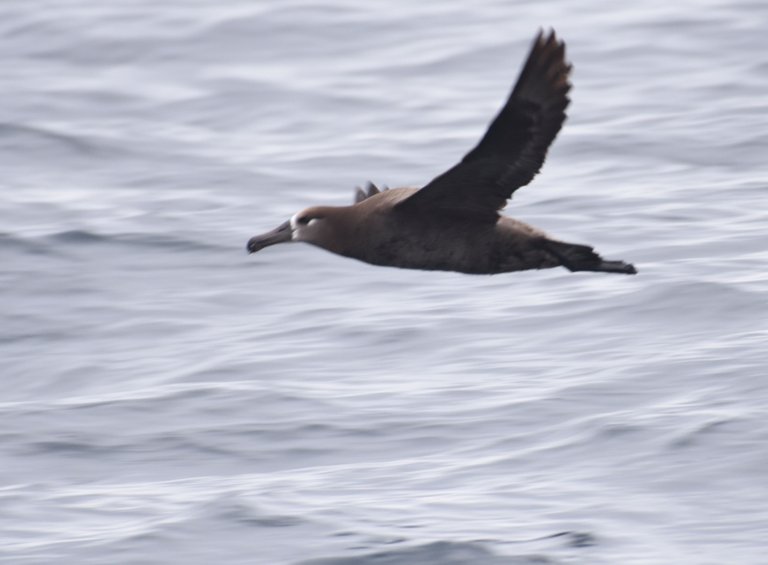
This is likely a young bird, with no white on the belly or undertail area, maybe a first or second year old bird.
The age of a Black-footed Albatross can be relatively estimated by the amount of white in the base of the tail and the belly, and maybe to a lesser degree on the face. The older birds have more white in these areas. Birds begin to breed between 5-8 years of age, and most individuals nest in 2 consecutive years, but often not in 3 consecutive years. How they know when to meet back at the nest site while spending up to 1 ½ years apart is a mystery. Hatching success is between 50-75%, with the biggest cause of failed nests being a single big storm that destroys the nest. About 25% of juveniles survive to breed, and thereafter the rate of failure to return to the nest site varies from 81-99%, likely depending on food supplies and weather events, with human fishery by-catch death the other major likely factor. Birds have been documented to have lived at least 40 years.
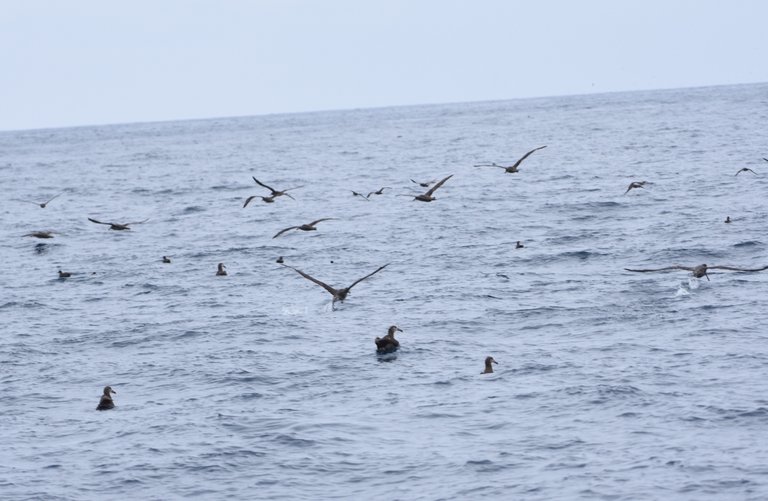
Another photo of a group of seabirds with many Black-footed Albatross.
In summary the Black-footed Albatross is the common all-dark albatross of the north Pacific Ocean, and the only albatross likely to be seen regularly in this region.
Good birding. Steem on!
amazing pix
Beautiful bird, I've never seen an albatross, let alone a whole group of them.
I love albatross's. They are elegant birds.
I agree. Thanks for the upvote and the resteem.
muy interesante post. hermosa especie
excellent shots! I heard that albatrosses are one of the biggest birds, is that so?
Yes. In terms of wingspan for sure, though there are much heavier land-based birds. Sailors used to consider seeing an albatross a good omen, and when one followed the ship it was considered very good karma.
We have another species from it. may be the same in the ordo or class of Species. maybe you will be interested to visit our research station. Many other species of flora fauna such as Sumatran Elephants, Sumatran bears, and Sumatran Tigers will be encountered in the wild in "SORAYA" station research.
magnificent birds, their way of life is impressive
World of Photography
>Visit the website<
You have earned 6.50 XP for sharing your photo!
Daily photos: 1/2
Daily comments: 0/5
Multiplier: 1.30
Block time: 2018-05-21T15:27:54
Total XP: 306.35/200.00
Total Photos: 51
Total comments: 0
Total contest wins: 0
Follow:
Join the Discord channel: click!
Play and win SBD:
Daily Steem Statistics:
Learn how to program Steem-Python applications:
Developed and sponsored by: @photocontests@fairlotto@dailysteemreport@steempytutorials @juliank
In the summer the black-footed albatross often follows fishing boats to feed on the waste. Its diet is made up of mostly fish, fish eggs and squid. It scoops up its food from the surface of the ocean. It catches most of its food at night.
hello, i like this post, i voted for you, i have followed you, hihi you, i have a private blog about coffee in steemit, maybe you like, i will share your opinion You will know there are many good things about my coffee blog, follow me, and vote for me, thank you, make a funny steemit.
I heard about Albatross but knew little about it .So thank you so much for giving the details about the bird.
Thanks for the resteem!
Your Post Has Been Featured on @Resteemable!
Feature any Steemit post using resteemit.com!
How It Works:
1. Take Any Steemit URL
2. Erase
https://3. Type
reGet Featured Instantly & Featured Posts are voted every 2.4hrs
Join the Curation Team Here | Vote Resteemable for Witness